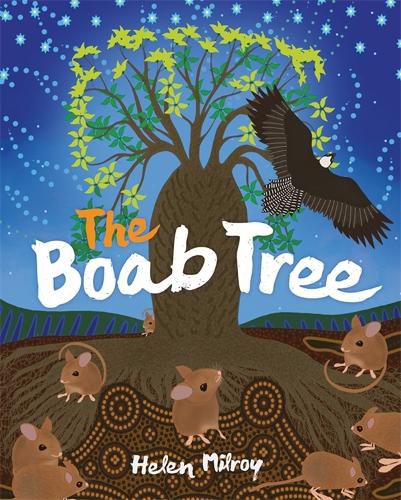The boab tree by Helen Milroy

Helen Milroy in telling a story of the natural environment and its interdependence, parallels the history of the First Nations people and their understanding of the environment in which they live.
Helen a descendant of the Palyku people of the Pilbara Region of Western Australia, has written eight books published by Fremantle Press, and her books have been short listed for awards in Australia. Her stories tell a tale which kids will love reading, and woven through that tale are lessons to be learnt about country, the interdependence of the fauna and flora within the environment and directions about living with each other.
With The boab tree, Helen tells a wonderful story about this magnificent tree, and tells us where it belongs in the environment, how it reproduces, its dependance on the leaf litter and the work of small animals beneath the canopy. And entwined with the story readers will learn of belonging, kindness and bravery as the tree finds its way home.
A pod is about to fall from the Boab tree. As it does a large eagle flies beneath the tree and the pod lands on its back. Unbeknownst to the eagle, it flies off and eventually the pod rolls off into an unknown forest of large trees, unlike those the pod has ever known. He is alone and calls out for help. Mice answer his call and ask him where he has come from. The mice offer their help. But the pod must open and release his seeds to propagate the next generation of Boab trees. The mice scrape away a little hole for the seeds and wait and wait for the green shoots to appear. This takes longer than expected and the tree grows very slowly. The soil is the wrong sort of soil, and the climate and surroundings are very different from where the Boab tree comes from.
One day a storm is predicted, and the mice help the little tree cling onto the surrounding branches and pile up the soil near his trunk, so that he survives. He wonders how he can help the mice who have been so kind to him. They tell him that one day they may be able to use his help. And of course, a time for help does come around. Foxes have returned to the forest. Usually the dingoes help the mice but they are not here, so the tree tells the mice to come inside his hollows. They do and the foxes run straight past.
One day a white feather falls to the ground and Boab recognises it. It is from an osprey, a large bird from his county. He sees Osprey is injured and calls the mice for ideas about how to restore him to health. The mice call the old possum and help him bring Osprey down to a makeshift nest formed in Boab’s branches, where he can rest and recover.
In return Osprey will help Boab move to his home. He flies back and tells everyone that he has found the little Boab tree. Together the community works to tie Boab to the eagles, ospreys, cockatoos and crows who are there to help. They fly off, lifting Boab into the sky. They find his place and position him on a ridge where he can look out over his country. And he does, growing to a large old tree, remembering his friends from the forest, and now and again the mice think they can hear Boab’s singing from a long time ago.
Paintings face each page of text, reflecting the story being told in dots, masses of colour and images of the animals. Young readers will love poring over the paintings, finding the things mentioned in the story, sharing the tale and what it tells them of the Boab tree and its place in the environment. Teaching notes are available.
Themes: Aboriginal stories, Boab tree Environment, Kindness, Bravery.
Fran Knight